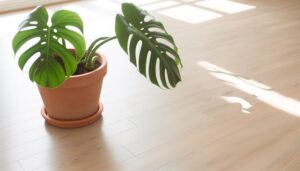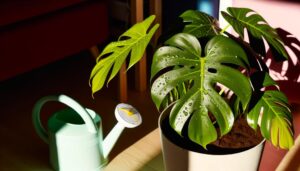Is Monstera a Tropical Plant? Find Out!
Yes, Monstera plants are unquestionably tropical. They originate from Central and South American rainforests, adapting to humid, low-light conditions.
You’ll notice their unique fenestrations—holes in the leaves—allow them to efficiently absorb light and withstand wind. These plants possess aerial roots that climb and absorb nutrients, embodying an epiphytic nature.
To thrive, they need humidity above 60%, temperatures between 65-85°F, and indirect sunlight akin to the rainforest canopy. Proper care includes well-aerated, nutrient-rich soil with good drainage.
By understanding these traits, you can nurture a Monstera effectively. Discover more about creating their ideal habitat.
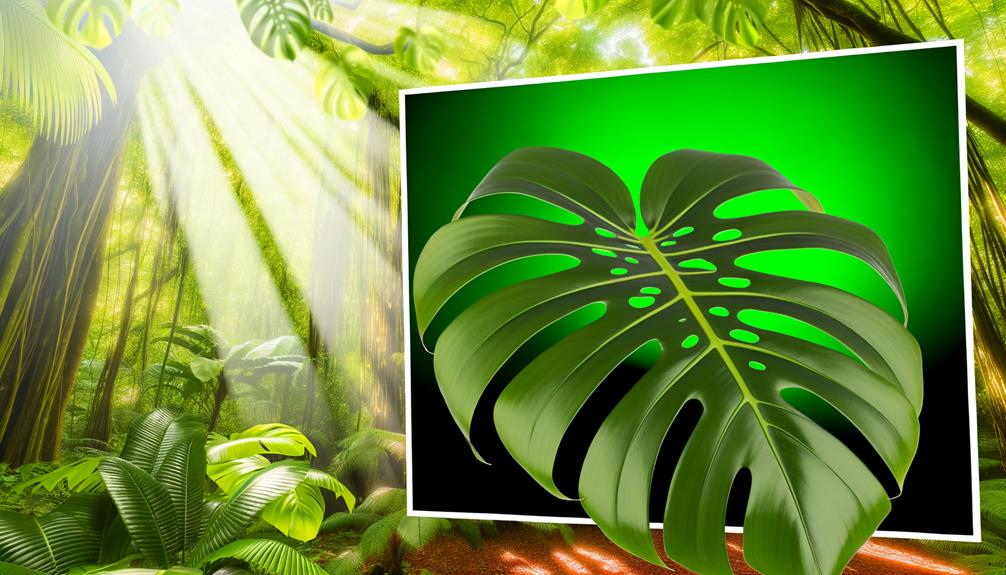
Key Takeaways
- Monstera plants originate from the tropical rainforests of Central and South America.
- They thrive in humid, low-light tropical rainforest conditions.
- Monstera requires humidity levels above 60% for optimal growth.
- These plants prefer temperatures between 65-85°F, typical of tropical climates.
- Monstera adapts well to indirect sunlight, simulating rainforest canopy light.
Monstera Origins
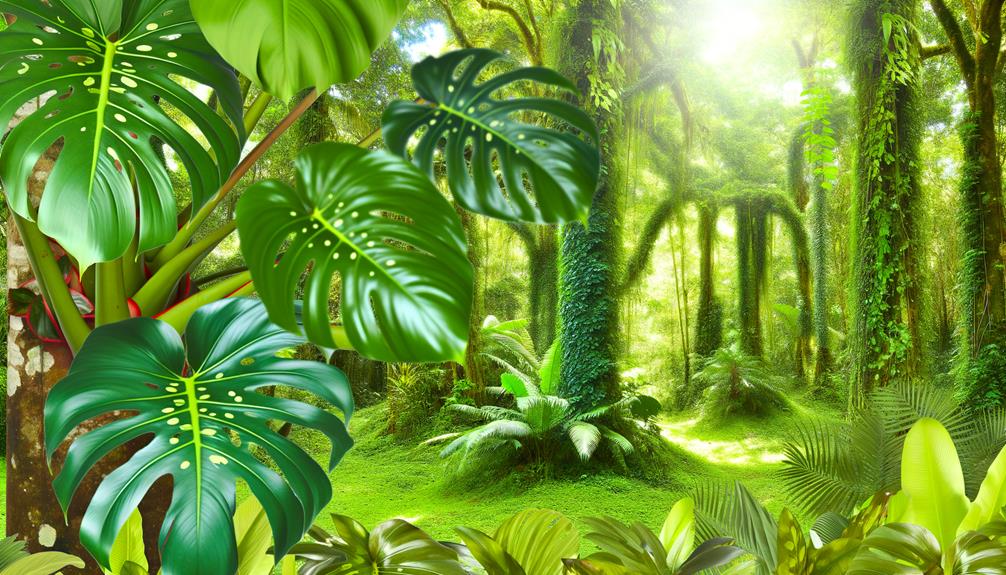
The Monstera plant, scientifically identified as Monstera deliciosa, originates from the tropical rainforests of Central and South America. You’ll find this plant’s unique fenestrations those eye-catching holes and splits in the leaves are adaptations to its native environment. These perforations allow light to filter through and reduce wind resistance, essential for survival in dense understory conditions.
The Monstera’s aerial roots, another distinctive feature, help it climb trees to reach sunlight while absorbing moisture and nutrients from the air. Its epiphytic nature means it often grows on other plants without harming them, making efficient use of space. Understanding these origins gives you insight into the Monstera’s adaptability and resilience, which are vital to its thriving presence in various environments today.
Natural Habitat
Given its origins, Monstera thrives in humid, low-light conditions typical of tropical rainforests, where it can climb and spread across the forest understory.
In its natural habitat, Monstera relies on certain environmental factors to flourish:
- Humidity: Consistent high humidity levels, often above 60%, are essential for best growth.
- Light: Indirect or dappled sunlight simulates the filtered light of the rainforest canopy.
- Temperature: Stable warm temperatures, typically ranging from 20°C to 30°C, support its growth cycle.
- Support Structures: Trees and other vertical surfaces provide necessary support for climbing and aerial root attachment.
These conditions enable Monstera to grow robustly, achieving its characteristic large, fenestrated leaves and extensive root systems, vital for nutrient absorption and stability in its native ecosystem.
Climate Preferences

You’ll find that Monstera flourishes in warm, humid environments, typically preferring temperatures between 65-85°F. It requires a humidity level of around 60-80% to simulate its native tropical conditions.
Understanding these climate preferences is essential for ensuring best growth and health.
Ideal Temperature Range
Monstera thrives in a temperature range of 65-85°F, ideally mirroring the warm, humid conditions of its native tropical habitat. To ensure peak growth, you should maintain consistent temperatures without drastic fluctuations. Sudden drops below 50°F can cause stress and damage to the plant.
Consider the following guidelines:
- Daytime Temperatures: Aim for 75-85°F to replicate daytime warmth in tropical climates.
- Nighttime Temperatures: Maintain 65-75°F to simulate cooler tropical nights.
- Avoid Drafts: Keep the plant away from cold drafts or direct air conditioning, which can cause temperature shock.
- Seasonal Adjustments: Slightly lower temperatures in winter are acceptable, but don’t let it drop below 60°F to prevent growth retardation.
Humidity Requirements
Humidity is crucial for the optimal growth of Monstera, requiring levels of at least 60% to replicate its native tropical environment. Insufficient humidity can result in suboptimal growth, browning leaf edges, and reduced aerial root development.
You should aim to create a microclimate that closely resembles a rainforest’s humid conditions. Use a hygrometer to monitor humidity levels accurately. If your indoor environment is too dry, consider using a humidifier, misting the leaves regularly, or placing the plant on a pebble tray filled with water to increase moisture levels.
Maintain proper air circulation to prevent fungal issues. By maintaining appropriate humidity, you’ll support Monstera’s lush, vigorous growth and overall health, mirroring its natural habitat requirements.
Tropical Characteristics
You’ll notice that Monstera thrives in warm climates, typically between 65-85°F, which is characteristic of tropical environments.
It also demands high humidity levels, often above 60%, to maintain its lush foliage.
These specific requirements indicate its adaptation to tropical regions.
Warm Climate Preference
Often thriving in regions with consistent warmth, the Monstera plant displays numerous characteristics typical of tropical flora. You’ll notice that these plants prefer temperatures ranging from 65°F to 85°F, reflecting their native environment’s climate. This preference for warmth is important for their best growth and health.
Consider these key points:
- Temperature Sensitivity: Monstera plants exhibit reduced growth below 60°F.
- Sunlight Exposure: They thrive best in indirect sunlight, mimicking the filtered light of tropical canopies.
- Growth Patterns: Warm temperatures facilitate vigorous growth and leaf development.
- Drought Tolerance: While not tolerant to drought, they withstand short dry spells if temperatures remain warm.
Understanding these preferences helps optimize your Monstera’s growth in suitable conditions.
High Humidity Needs
An essential aspect of Monstera’s tropical nature is its high humidity requirements, often needing levels above 60% for best health. You’ll notice that Monstera thrives in environments mirroring its native rainforests, where ambient moisture is consistently high.
This plant’s aerial roots absorb moisture from the air, aiding in nutrient uptake and overall vigor. Without sufficient humidity, you’ll see signs of stress like browning leaf edges and slower growth. To achieve ideal conditions, consider using a humidifier, misting the leaves, or placing the plant on a tray filled with water and pebbles.
Monitoring humidity levels with a hygrometer ensures accuracy. Understanding and meeting these humidity needs are essential for maintaining a healthy and flourishing Monstera in your home.
Growth Patterns

Monstera plants exhibit diverse growth patterns, characterized by their climbing vines and aerial roots that anchor to nearby surfaces for support. You’ll notice that these plants adapt to their environment by orienting their growth towards light sources and utilizing structural support systems.
The following are key growth characteristics:
- Climbing Habit: Monstera’s vines naturally climb, using trees or trellises.
- Aerial Roots: These roots extend from stems, enabling the plant to secure itself to surfaces.
- Leaf Fenestration: Mature leaves develop splits and holes, optimizing light absorption.
- Rapid Growth: Under ideal conditions, Monstera can grow several feet annually.
Understanding these growth patterns will help you provide the proper care and environment for your Monstera plant, ensuring its healthy development.
Light Requirements
To optimize the rapid growth and fenestration of your Monstera, make sure it receives bright, indirect light, mimicking its natural tropical habitat. Monstera thrives in environments where sunlight is filtered through the canopy of larger trees. Direct sunlight can scorch its leaves, causing photodamage and reducing aesthetic appeal.
Place your Monstera near an east or west-facing window, making certain it gets ample light without direct exposure. Use sheer curtains if necessary to diffuse intense sunlight. Monitor leaf color and growth patterns; yellowing leaves may indicate too much light, while slow growth suggests insufficient lighting.
Additionally, rotating the plant periodically guarantees even light distribution, promoting symmetrical growth. This light regimen maintains the health and vibrancy of your Monstera, enhancing its ornamental value.
Watering Needs

Ensuring best hydration for your Monstera involves understanding its preference for consistently moist, yet well-draining soil, which mirrors the humid, tropical forests it originates from.
To achieve prime watering conditions, adhere to the following guidelines:
- Frequency: Water your Monstera when the top inch of soil feels dry to the touch. Over-watering can lead to root rot.
- Volume: Provide sufficient water so that it flows through the drainage holes, ensuring complete soil saturation without waterlogging.
- Humidity: Maintain high humidity levels, ideally between 60-80%. Use a humidifier or mist the leaves regularly.
- Seasonal Adjustments: Reduce watering frequency during winter months when the plant’s growth slows down.
Soil Conditions
Perfect soil conditions for a Monstera necessitate a well-aerated, nutrient-rich blend that promotes healthy root development and prevents water retention. You’ll want to use a potting medium that combines peat moss, perlite, and pine bark. This mixture guarantees excellent drainage while retaining sufficient moisture.
Peat moss provides the organic matter essential for nutrient retention, while perlite enhances aeration, reducing the risk of root rot. Pine bark improves the structural integrity of the soil, ensuring longevity and preventing compaction.
Avoid using heavy, clay-based soils as they retain water excessively, leading to potential root damage. By maintaining these conditions, you’ll create an ideal environment that supports robust growth and vibrant foliage in your Monstera.
Humidity Levels
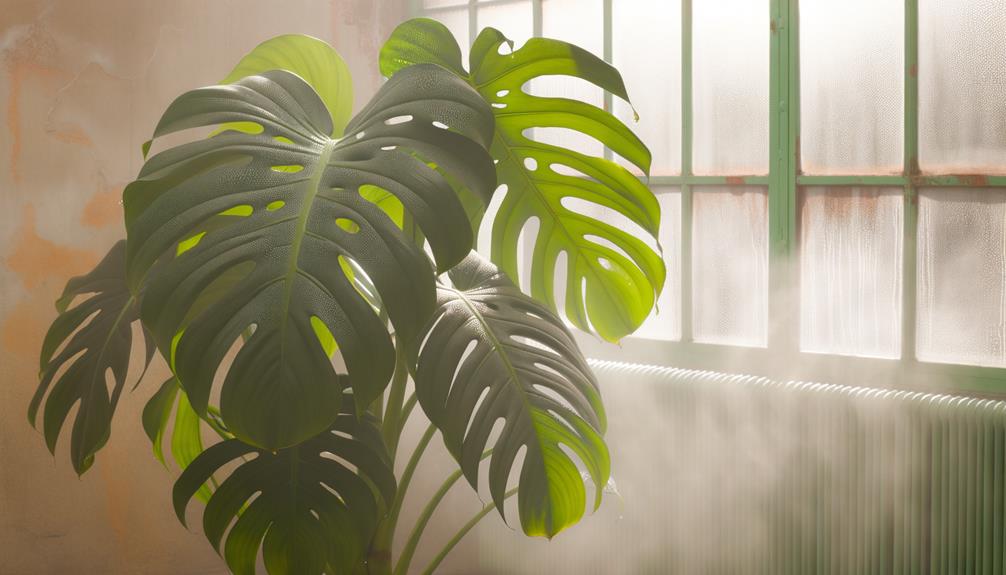
Maintaining high moisture levels, ideally between 60% and 80%, is essential for the healthy growth and vibrant foliage of a Monstera. This tropical plant thrives in damp environments, mimicking its natural habitat. Without sufficient moisture, you’ll notice leaf browning, slowed growth, and potential pest infestations.
To ensure peak moisture levels, consider the following methods:
- Humidifiers: Place a humidifier near your Monstera to maintain consistent dampness levels.
- Pebble Trays: Fill a tray with pebbles and water, then place the pot on top, allowing evaporation to enhance moisture.
- Misting: Regularly mist the leaves to provide a temporary moisture increase.
- Grouping Plants: Position your Monstera near other plants to create a microenvironment with higher moisture.
These strategies will help maintain your Monstera’s lush, vibrant appearance.
Indoor Care Tips
When caring for your Monstera indoors, make sure you maintain consistent moisture by watering it when the top inch of soil feels dry.
Place it in a location with bright, indirect sunlight to mimic its natural tropical habitat.
Additionally, keep the humidity levels around 60% to support its lush foliage.
Watering and Humidity Needs
For best growth, your Monstera requires consistently moist soil and a humidity level between 60% to 80%. Make sure you’re not over-watering, as waterlogged soil can lead to root rot.
Follow these guidelines for prime care:
- Watering Schedule: Water when the top inch of soil feels dry. Use room-temperature, filtered water.
- Humidity Maintenance: Utilize a hygrometer to monitor humidity levels. If necessary, employ a humidifier.
- Misting: Mist the leaves with distilled water to replicate tropical conditions, preventing pest infestations.
- Drainage: Make certain your pot has adequate drainage holes to prevent water accumulation.
Optimal Light Conditions
Alongside proper watering and humidity, your Monstera thrives in bright, indirect light to mimic its natural tropical habitat. Position it near an east or north-facing window to provide best light levels without direct sun exposure, which can cause leaf burn.
Monstera plants utilize photosynthesis effectively under these conditions, promoting strong growth and vibrant leaf fenestration. Avoid placing it in low-light areas, as insufficient light inhibits chlorophyll production, leading to stunted growth and yellowing leaves. If natural light is limited, consider using full-spectrum grow lights to supplement.
Monitor the plant’s response: leggy growth indicates inadequate light, while scorched leaves suggest excessive direct sunlight. Adjust accordingly to maintain ideal lighting conditions for your Monstera’s health and importance.
Conclusion
To sum up, you’ll discover that caring for a Monstera is like recognizing ‘the devil is in the details.’
This tropical plant flourishes in warm, humid settings with well-draining soil and regular watering. By replicating its natural surroundings, you can promote strong growth and colorful foliage.
Keep in mind, maintaining adequate humidity levels is essential for its well-being.
With these observations, you’re well-prepared to cultivate your Monstera and relish its luxurious, exotic beauty indoors.



